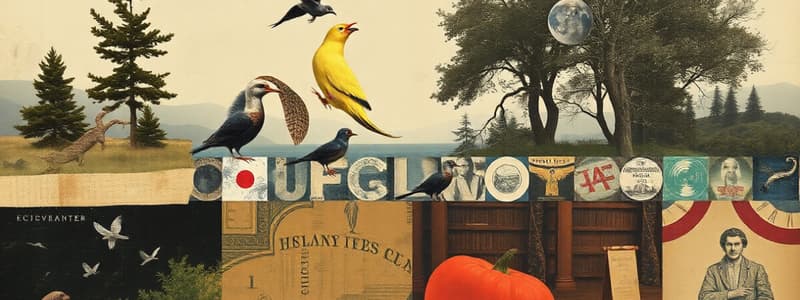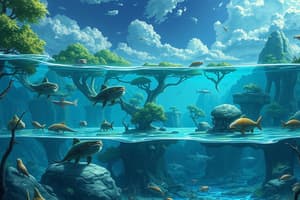Podcast
Questions and Answers
What is an ecosystem?
What is an ecosystem?
An ecosystem is a community of living organisms and the non-living components.
What are the two main categories of components within an ecosystem?
What are the two main categories of components within an ecosystem?
Biotic and abiotic components
What does 'biotic' refer to?
What does 'biotic' refer to?
Living things
Which of the following are examples of biotic components?
Which of the following are examples of biotic components?
What is the role of producers in an ecosystem?
What is the role of producers in an ecosystem?
What are some examples of producers?
What are some examples of producers?
Which of the following are types of consumers?
Which of the following are types of consumers?
What do herbivores eat?
What do herbivores eat?
What do scavengers eat?
What do scavengers eat?
What is the role of decomposers in an ecosystem?
What is the role of decomposers in an ecosystem?
What are some examples of decomposers?
What are some examples of decomposers?
What is a food chain?
What is a food chain?
What is symbiosis?
What is symbiosis?
Which of the following are types of symbiosis?
Which of the following are types of symbiosis?
What is mutualism?
What is mutualism?
What is commensalism?
What is commensalism?
What is parasitism?
What is parasitism?
What is a non-symbiotic relationship?
What is a non-symbiotic relationship?
Which of the following are examples of non-symbiotic relationships?
Which of the following are examples of non-symbiotic relationships?
What is competition?
What is competition?
What is predation?
What is predation?
What is acid rain?
What is acid rain?
What is global warming?
What is global warming?
Producers are heterotrophic organisms that get their energy from eating other organisms.
Producers are heterotrophic organisms that get their energy from eating other organisms.
Decomposers break down dead organic matter and recycle nutrients back into the ecosystem.
Decomposers break down dead organic matter and recycle nutrients back into the ecosystem.
In mutualism, one organism benefits and the other is not affected.
In mutualism, one organism benefits and the other is not affected.
In a food chain, energy flows from consumers to producers.
In a food chain, energy flows from consumers to producers.
Acid rain is a result of pollution caused by burning fossil fuels.
Acid rain is a result of pollution caused by burning fossil fuels.
Global warming is solely caused by natural fluctuations in the Earth's climate system.
Global warming is solely caused by natural fluctuations in the Earth's climate system.
Competition is an ecological interaction between organisms where two or more organisms need the same thing in order to survive.
Competition is an ecological interaction between organisms where two or more organisms need the same thing in order to survive.
Predation is an ecological interaction where a predator feeds on a prey.
Predation is an ecological interaction where a predator feeds on a prey.
Flashcards
Abiotic Factors
Abiotic Factors
The non-living components of an ecosystem, such as water, sunlight, air, soil, temperature, and minerals.
Biotic Factors
Biotic Factors
Living components of an ecosystem, including all forms of life, such as plants, animals, fungi, bacteria.
Ecosystem
Ecosystem
A community of living organisms interacting with each other and their non-living environment.
Producers
Producers
Signup and view all the flashcards
Consumers
Consumers
Signup and view all the flashcards
Herbivores
Herbivores
Signup and view all the flashcards
Carnivores
Carnivores
Signup and view all the flashcards
Omnivores
Omnivores
Signup and view all the flashcards
Scavengers
Scavengers
Signup and view all the flashcards
Decomposers
Decomposers
Signup and view all the flashcards
Food Chain
Food Chain
Signup and view all the flashcards
Food Web
Food Web
Signup and view all the flashcards
Trophic Level
Trophic Level
Signup and view all the flashcards
Ecological Pyramid
Ecological Pyramid
Signup and view all the flashcards
10% Law
10% Law
Signup and view all the flashcards
Symbiosis
Symbiosis
Signup and view all the flashcards
Parasitism
Parasitism
Signup and view all the flashcards
Commensalism
Commensalism
Signup and view all the flashcards
Mutualism
Mutualism
Signup and view all the flashcards
Non-Symbiotic Relationship
Non-Symbiotic Relationship
Signup and view all the flashcards
Competition
Competition
Signup and view all the flashcards
Predation
Predation
Signup and view all the flashcards
Acid Rain
Acid Rain
Signup and view all the flashcards
Global Warming
Global Warming
Signup and view all the flashcards
Ecological Interactions
Ecological Interactions
Signup and view all the flashcards
Ecology
Ecology
Signup and view all the flashcards
Biodiversity
Biodiversity
Signup and view all the flashcards
Speciation
Speciation
Signup and view all the flashcards
Species
Species
Signup and view all the flashcards
Adaptation
Adaptation
Signup and view all the flashcards
Natural Selection
Natural Selection
Signup and view all the flashcards
Evolution
Evolution
Signup and view all the flashcards
Study Notes
Ecosystems
-
An ecosystem: community of living organisms and the nonliving components.
-
Producers: autotrophs, making their own food (e.g., plants).
-
Consumers: heterotrophs, obtaining energy by consuming others (e.g., herbivores, carnivores, omnivores, scavengers).
-
Decomposers: heterotrophs that break down dead organic matter (e.g., bacteria, fungi).
-
Producers: autotrophic organisms that contain chlorophyll and make their own food through photosynthesis using sunlight.
-
Consumers: organisms that get their energy by eating other organisms.
-
Herbivores: eat plants.
-
Carnivores: eat animals.
-
Omnivores: eat both plants and animals.
-
Scavengers: consume dead organisms.
-
Herbivores: feed on vegetation or primary consumers within an ecosystem.
-
Carnivores: prey on other animals, possibly secondary consumers or tertiary consumers.
-
Omnivores: feed on both plants and other consumers.
-
Scavengers: feed on dead animals or plant matter.
-
A food chain: linear sequence of organisms where each organism feeds on the one below.
-
A food web: multiple food chains interconnect.
-
A food web :shows feeding relationships among different organisms.
-
An ecological pyramid: graphical representation of trophic levels.
-
Symbiosis: close relationship between two different species.
a. Mutualism: Both species benefit.
b. Commensalism: One species benefits, the other is unaffected.
c. Parasitism: One species benefits, the other is harmed.
-
Non-Symbiotic relationships: ecological interactions where organisms live apart from one another..
-
Competition: ecological interaction between two or more organisms needing the same resource.
-
Predation: ecological interaction where one organism (predator) feeds on another (prey.)
-
Global Warming: increasing average temperature of Earth's atmosphere.
Studying That Suits You
Use AI to generate personalized quizzes and flashcards to suit your learning preferences.




